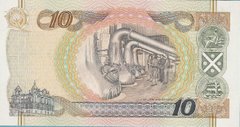I took a walk one afternoon this summer up the Gully Trail at Greenhorn Park. Eventually it peters out and joins the Humbug-Big Ditch trail junction, and if you keep climbing you get to a road that leads to the top of the ridge. Mountain bike riders call that stretch "The Wall" because it is steep and very hard going. I have yet to make it to the top on my bike, but my feet got me there well enough. One of the road cuts on a wide switchback glistens with a grayish-green rock outcrop that screams "serpentine" to the native Californian. Sure enough, there's serpentinization, but that's just on the surface. I cracked a few of the scattered cobbles open and was presented with an opaque black rock that fractured easily. Back home, it showed little or no cleavage, a minute and hard to discern crystal structure, left a black streak, and attracted a compass needle. It was magnetite, an ore of iron.
I was looking, actually, for chromite, an ore of chromium that contains much iron--the whole county is riddled with the stuff. The Klamaths sit on a basement of peridotite, a rock formed in the mantle. Ancient bits of old seafloor have been thrust landward by the inexorable grinding of the tectonic plates. These rocks are known as ultramafic to the geologist--silicates rich in magnesium and iron. Mineralization occurs along fault lines and contact points with younger igneous material. Magnetite is interesting in that it shows both of iron's oxidation states, what were once called the ferrous and ferric forms. Nowadays the more prosaic iron(II) and iron(III) are used. FeO, iron(II) or ferrous oxide, found alone is called Wustite by the mineralogist. Fe2O3, iron(III) or ferric oxide, is the better-known hematite. The magnetite form is known as iron (II, III) oxide and can be written Fe3O4. All three minerals can occur as commercial-grade iron ores. Magnetite is used as a catalyst in the Haber Process that converts ("fixes") atmospheric nitrogen and produces ammonia. Ammonia is one of the cornerstone chemicals of the industrial world as it can be easily oxidized to make fertilizers and explosives, and is also the basis of some plastics, fibers, dyes, and pharmaceuticals. About 130,000,000 metric tons are produced annually worldwide.
I wasn't thinking of any of that when I huffed by on my Stumpjumper last week. I was just trying to keep up a steady pedaling and not get out of breath. It was hot, my face was flushed, sweat was pouring down my cheeks, and my heart was beating with a fury inside my chest. Between my feet and my wheels, I hope to stumble across many more cool rocks and minerals here in the State of Jefferson.
Another new pitcher
-
"Stockpile starters" is a winning strategy in my book and the Giants have
made another step in that direction. It isn't sexy or flashy, but it's
solid, a...
6 days ago







No comments:
Post a Comment